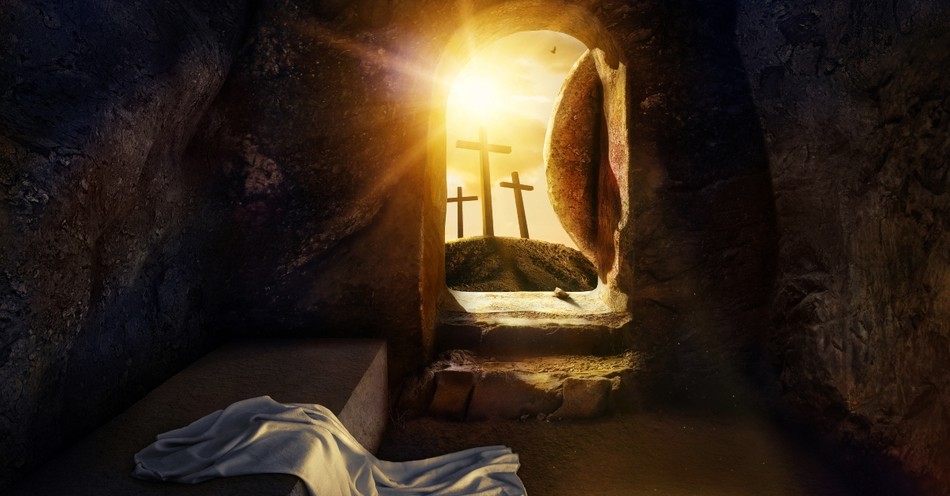The Bible teaches that Jesus was crucified on a Roman cross and then buried in a borrowed tomb. But, on the third day after his crucifixion, the women who had been followers went to his tomb and found it empty. They told the disciples, some of whom also went to the tomb and found it empty. And they left wondering what had happened to Jesus’ body?
Today, the empty tomb is accepted with little question by most evangelical believers and is a core tenet of our faith. But I suspect that most of us never really invest much time and effort in understanding its importance. Why is the empty tomb significant in Christianity? Why is the empty tomb so central to each of the gospel narratives?
Get your FREE Easter Guide here. Have encouragement delivered straight to your inbox!
The Resurrection and the Empty Tomb
The resurrection of Jesus from the dead has been at the heart of the gospel message from the beginning. In 1 Corinthians 15:3-5 Paul expressed what most believe to have been a creed of the early church.
For what I received I passed on to you as of first importance: that Christ died for our sins according to the Scriptures, that he was buried, that he was raised on the third day according to the Scriptures, and that he appeared to Cephas, and then to the Twelve.
But while the resurrection and the empty tomb are bound together, they are distinct. In the resurrection, Jesus demonstrated his mastery over death and it holds promise for believers as well; that we also will have victory over death.
But, unlike the resurrection, the empty tomb does not do anything for us. Instead, it tells us something. It tells us that the grave could not hold Jesus. That he bodily rose from the grave:
There was a violent earthquake, for an angel of the Lord came down from heaven and, going to the tomb, rolled back the stone and sat on it. His appearance was like lightning, and his clothes were white as snow. The guards were so afraid of him that they shook and became like dead men. The angel said to the women, “Do not be afraid, for I know that you are looking for Jesus, who was crucified. He is not here; he has risen, just as he said. Come and see the place where he lay. Then go quickly and tell his disciples: ‘He has risen from the dead and is going ahead of you into Galilee. There you will see him.’ Now I have told you.” So the women hurried away from the tomb, afraid yet filled with joy, and ran to tell his disciples. Suddenly Jesus met them. “Greetings,” he said. They came to him, clasped his feet and worshiped him. Then Jesus said to them, “Do not be afraid. Go and tell my brothers to go to Galilee; there they will see me." (Matthew 28:2-10)
When the angel appeared to the women at the empty grave, he told them, “He is not here; he has risen, just as he said. Come and see the place where he lay.” The empty tomb told them that Jesus had indeed been raised. It was evidence of the resurrection.
The Empty Tomb as a Symbol
Different traditions within Christianity have their own symbols that represent significant events or teachings within the Christian faith. One that is universal is the cross. The cross itself has no saving power. But it symbolizes what Jesus did for us. Jesus’ death on the cross was as an atoning sacrifice for our sin. And the cross is a symbol of that. When we see the cross, we are reminded of what Jesus did.
In the same way, the empty tomb is a symbol of the resurrection. When we see or hear of the empty tomb, it should point us to Jesus’ resurrection. And to our own upcoming resurrection as well. It symbolizes victory over death.
But, while the cross is an easy symbol to put on a chain and hang around your neck, the empty tomb is not. I can’t recall ever seeing an empty tomb on a chain or at the front of a sanctuary. Instead, we might see an empty cross as representing both. Jesus is no longer on the cross, he is not dead, he has risen!
Alternatives to the Empty Tomb
The empty tomb points to the bodily resurrection of Jesus. But that is offensive to many people who discount the miraculous, or who deny the divinity of Jesus. So instead they have developed alternative theories to explain away the empty tomb. These theories include:
- The women, and later the disciples, mistakenly went to the wrong tomb.
- The disciples stole the body of Jesus and claimed he was resurrected.
- Joseph of Arimathea moved the body from his family tomb and then neglected to tell anyone.
- The account of an empty tomb was simply a legend that developed in the decades following Jesus' crucifixion.
But all of these are simple to refute. The belief in the resurrection, and resulting empty tomb, is well attested in the early church. The creed quoted by Paul in 1 Corinthians 15:3-5 is generally believed to have been developed within two decades of Jesus’ death and resurrection. That is much too early for legends to have developed and early enough for critics to have produced the body of Jesus had he not been resurrected.
Evidence for the Empty Tomb
The earliest disciples of Jesus had no need for evidence of the empty tomb. They could see it for themselves. But what assurance can we have today that the tomb really was empty? That Jesus did indeed rise from the dead?
The evidence for the empty tomb is really the same as the evidence for the bodily resurrection of Jesus. Dr. William Lane Craig, in his article The Resurrection of Jesus, offers three pieces of evidence for the empty tomb.
1. If the tomb had not been empty, someone would have produced Jesus’ body.
2. There are well-documented appearances of Jesus appearing after his resurrection in all four gospels, as well as in 1 Corinthians.
3. It best describes the belief of the early disciples that he had risen. A belief that would have been foreign to first-century Jews.
Over the years, there have been many skeptics who have sought to explain away the empty tomb. Among them is Frank Morison, a skeptic who sought to write a rebuttal to the story of the resurrection. But during his research for the book, he became convinced that the tomb was empty. So instead he wrote, Who Moved the Stone in defense of the empty tomb.
Why Is the Empty Tomb Important?
So, in the end, why is the empty tomb important? I believe its primary importance is that it points to the bodily resurrection of Jesus. That death could not hold him. And, secondarily, because Jesus has risen, we can look forward to our own resurrection as well. The empty tomb demonstrates that death is not the end of the journey. There is much more to come.
Further Reading:
Do We Know Where Jesus Was Buried?
Bible Verses About the Burial and Tomb of Jesus Christ
Why Did Only the Women Go to Jesus’ Tomb?
Photo Credit: ©iStock/Getty Images/TanyaSid





